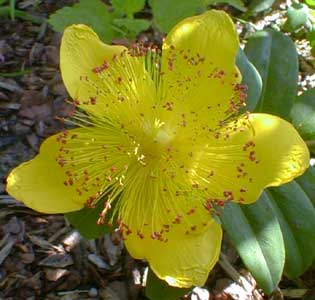
Aaron's Beard; or,
Creeping St. John's Wort; or,
Goldflower
"Each tree, herb, flowre
Are shadows of his wisedome."
-Henry Vaughan
(1621-1695)
(1621-1695)
Most of the Hypericum species go by the common name "St. John's Wort" named for John the Baptist, but the name "Aaron's Beard" is commonly used of H. calycinum & takes its inspiration from Psalm 133:2 regarding "the precious ointment upon the head, running down upon the beard, running down upon the beard of Aaron, running down upon the hem of his garment," which some have been read to indicate that Aaron's beard grew to the hem of his priestly robe.
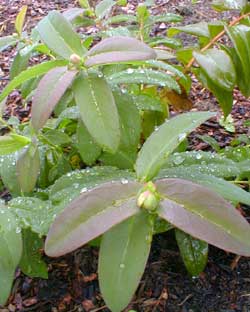 The Psalm alludes to the ointment with which Moses annointed his brother to establish the priestly lineage [Exodus 29:7; 30:25-31]. The assumption is that an oil extracted from Hypericum was used in a mixture with other aromatic oils in the manufacture of the ointment of sacred consecration.
The Psalm alludes to the ointment with which Moses annointed his brother to establish the priestly lineage [Exodus 29:7; 30:25-31]. The assumption is that an oil extracted from Hypericum was used in a mixture with other aromatic oils in the manufacture of the ointment of sacred consecration.To fail to take care of one's beard was a sign of insanity [1 Samuel 21:13], & any injury to or cutting of one's beard signified disgrace [2 Samuel 10:4] or grief [Isaiah 15:2; Jeremiah 48:37]. Hence Aaron's lengthy & annointed beard indicated a state of perfect grace, an idea taken quite seriously in Islamic faith as well as conservative Judaism.
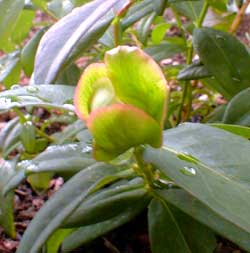 As a native wildflower of Bulgaria & Turkey, it is not at all likely to have been a source of the actual consecreting oil of the priestly class. The species gained its association not for the sake of its extracts, but because the large five-petalled brightly golden flower has the most awesome fuzzy stamins, like a yellow fluff, quite like a tuft of hair, or a beard.
As a native wildflower of Bulgaria & Turkey, it is not at all likely to have been a source of the actual consecreting oil of the priestly class. The species gained its association not for the sake of its extracts, but because the large five-petalled brightly golden flower has the most awesome fuzzy stamins, like a yellow fluff, quite like a tuft of hair, or a beard.Its flowering strength is dramatic, & even when the bright yellow petals are spent & fall from the branchings, sepals remain (as in the final photo below) looking like a smaller yellowish green flower.
Especially in the UK, Aaron's Beard is occasionally called by another biblically referential name, Rose of Sharon. Scripture's Rose of Sharon, however, was a flowering bulb, most likely a daffodil (specifically, Narcissus tazetta). But as a modern common name, Rose of Sharon has in North America become most strongly identified with Hybiscus syriacus. (For an additional photo of Aaron's Beard & for a full consideration of the great body of Rose of Sharon myths, see my essay on "The Mythological Associations of the Rose of Sharon."(
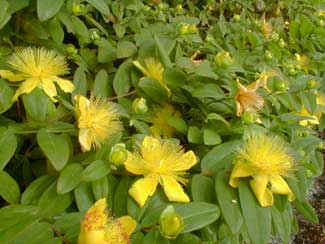 The leaves are a bright light green, paler with a netting pattern on the underside. It is evergreen here in temperate zone 8, but will die back in winter in cold climates, nevertheless doing very well down to zone 5. The second photo shows it early in May before its buds are particularly swollen, showing how pleasant it can be as a creeping shrub even apart from its blooming season. The third photo shows the rapidly developing buds later in May.
The leaves are a bright light green, paler with a netting pattern on the underside. It is evergreen here in temperate zone 8, but will die back in winter in cold climates, nevertheless doing very well down to zone 5. The second photo shows it early in May before its buds are particularly swollen, showing how pleasant it can be as a creeping shrub even apart from its blooming season. The third photo shows the rapidly developing buds later in May.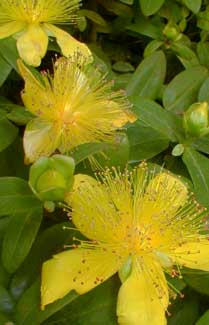 While other species of Hypericum are floppy or fountaining sub-shrubs, Aaron's Beard is more nearly a creeping vine. It can spread by its rhyzomes to cover an extensive area, but rarely lifts its prostrate twigs higher than a foot or eighteen inches. A quarter-block away from us across the street is an extensive area of half-wild stretches of Aaron's Beard that are heaped higher than this average, by piling itself creeping vine atop creeping vine.
While other species of Hypericum are floppy or fountaining sub-shrubs, Aaron's Beard is more nearly a creeping vine. It can spread by its rhyzomes to cover an extensive area, but rarely lifts its prostrate twigs higher than a foot or eighteen inches. A quarter-block away from us across the street is an extensive area of half-wild stretches of Aaron's Beard that are heaped higher than this average, by piling itself creeping vine atop creeping vine.It is capable of really taking over a sunny area & displacing other plants. We've not planted it in our yard because it is too aggressive, potentially an invasive species as a groundcover. It is so commonly planted along roadsides that it is frankly over-used, & for my own tastes I'd rather see mixed xeriscape gardens than great expanses of Aaron's Beard. It erupts in our gardens at times as a volunteer & I sometimes let it spread for a while if there's nothing it'll interfer with, but eventually I dig it out to compost.
But that is not to say I am not fond of Aaron's Beard. It is a beautiful flower & I love that it is named for Aaron the brother of Miriam & Moses, all three of whom I rather cherish. About Miriam especially, given a willing ear that wouldn't be bored to death, I can tell strange mystical tales of the Exodus drawn from midrashim (the "sacred lies" or fairy lore that takes all its touchstones from Torah, the Bible).
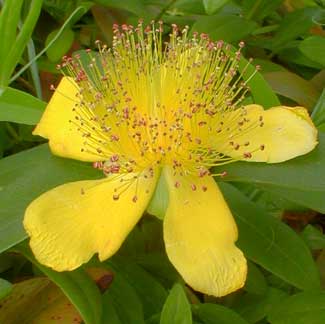 I love the legends attached to many of the plants in the gardens around our home, & I do sometimes suspect I would plant even something ugly-ass if its common name was Bathsheba.
I love the legends attached to many of the plants in the gardens around our home, & I do sometimes suspect I would plant even something ugly-ass if its common name was Bathsheba.Which is not to say I'm particularly religious; some people fell in love with The Lord of the Rings & never got over that one great work in their whole lives. I fell in love with Torah, & I get from it what others get from science fiction, plus a lot more that informs our society's arts, culture & imagination.
For a while we had Aaron's beard (which provided the first three photos) growing on our roadside surrounded by rugosa roses, themselves so aggressive the rugosas kept Aaron's beard from spreading too much. I let it go rather long before digging it out, but it keeps coming back from missed fragments, proving itself weedy indeed.
Aaron's Beard takes well to a radical sheering to keep it compact, low-growing, & flowery. The second set of three photos were taken in mid-June from two of the three huge half-wild patches of Aaron's beard growing across the street & further down our block.
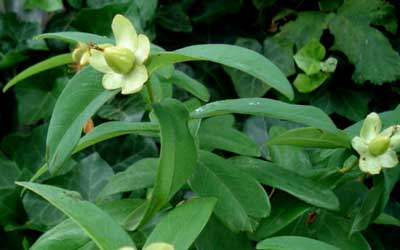 If the yards that have used it were mine I'd likely get rid of nine-tenths of the Aaron's Beard & plant a variety of things where presently a single species is predominant, but when in full flower one has to admit it's a dramatic groundcover.
If the yards that have used it were mine I'd likely get rid of nine-tenths of the Aaron's Beard & plant a variety of things where presently a single species is predominant, but when in full flower one has to admit it's a dramatic groundcover.It is so invasive because it is a wild species rather than a cultivar, yet as a complete dense groundcover it is the most effective of all the hypericums. It should be cut back early each spring both because it flowers only on new limbs, & so that it will not get too awfully leggy or spread too burdensomely out of hand. For an excellent alternative to Aaron's Beard, there is a highly recommendable hybrid cultivar which preserves the enormity of the H. calycinum flower, though the "beard" isn't quite so fluffy, namely H. x 'Hidcote.'
By no means fussy about conditions, it's very drought-hardy. It is slightly less flowery in dappled sunlight or bright shade, where it is even more drought-hardy. It will do well enough in deeper shade, too, though with fewer blossoms. It does well in rich humusy soil or in poorer alkaline soil, being extremely adaptable.
Because of its fast-spreading stoloniferous root system it is sometimes used to firm up embankments. However, though it survives droughty neglected locations, it rarely looks its best when used in no-care parking lots, where it doesn't get its spring sheering or the occasional watering it requires to bloom its best.